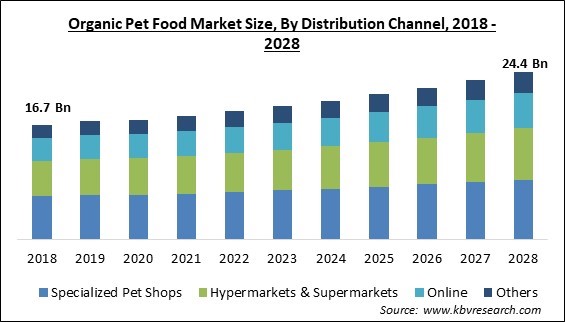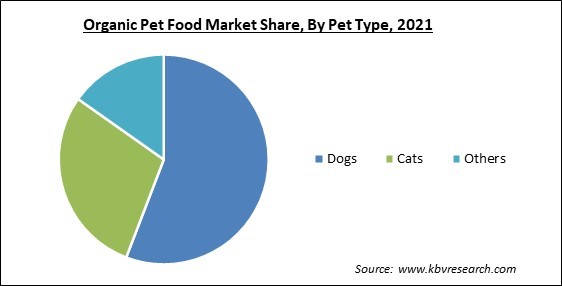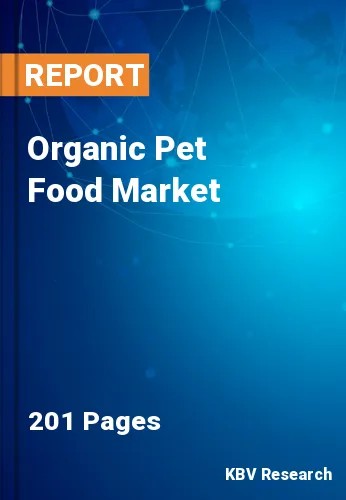The Global Organic Pet Food Market size is expected to reach $24.4 billion by 2028, rising at a market growth of 4.6% CAGR during the forecast period.
Due to the growing humanization of pets and high expenditure on pet items, organic pet food is rising. Individuals who buy organic items adopt the same buying habits for their dogs. In addition, people demand clean-label organic pet meals to avoid the adverse side effects of synthetic and chemical ingredients in conventional pet food. As a consequence of changing consumer beliefs toward pet health, there is an increase in demand for organic and natural pet food.

The surge in the popularity of the nuclear family is one of the causes fueling the demand for organic pet food. Furthermore, a greater understanding of pet health drives the demand for organic pet food. In addition, as pet adoption and humanization rates climb globally, there is a surge in demand for organic pet food. Due to increased commercials, attempts to increase public awareness of problems affecting pets' health, and celebrity endorsements, the market for organic pet food is growing.
The increase in disposable income and changing consumer lifestyles are also driving up demand for and the growth of the organic pet food market. Vitamins, proteins, fatty acids, amino acids, and minerals are added to organic pet food. They lack genetically engineered products, artificial flavors or colors, and preservatives. Based on the breed and age of the animal, they are created. The growing interest in pet health and the appeal of organic goods are related.
The nutritional content of these items is higher than that of regular pet food. The need for product composition clarity is another motivator. In recent years, there have been more endorsements and commercials concerning pet health awareness, which has led to a rise in the popularity of organic pet food. The adoption of stray and wounded animals by people has increased demand for the good. Social media's active involvement in promoting pet care services has fueled the trend toward nutritious pet food.
Due to prolonged lockdowns in many locations, limits on international commerce, the closure of production facilities, travel bans, supply chain constraints, and a scarcity of raw materials, the COVID-19 pandemic has dramatically impacted the manufacturing sector's operating efficiency. The pandemic has affected the organic pet food market because production facilities have been shut down, raw material costs have increased, there is a labor shortage, supply chains have been disrupted, and the economy is unstable.
To protect pets' health, hygienic and healthful pet food is essential. As a result, pet owners like to purchase high-quality pet food. Compared to conventional goods, food with holistic, organic, and natural labels tends to draw more consumers. Often, by-products of the food manufacturing industry, like chicken skin and bones, are used to make pet meals. However, if the raw material employed is treated with additional antibiotics, such procedures might result in foodborne diseases. In order to stop the spread of foodborne illnesses that may be brought on by pet food, the supply chain must be managed from the first handling step to the last.
Internet platforms are becoming a common occurrence. Pet owners often use social media in their everyday lives, and many of them use it to study things before buying them for their dogs. Customers that shop online utilizes a variety of search engines, including Google, Amazon, YouTube, and others, in addition to asking friends and social media influencers for suggestions. In light of this, social media is becoming a crucial tool for online pet food companies for various reasons, including the ability to instantly notify clients about the most current information from their firm. This supports the growth of the regional market.

Pet food businesses are required to file patent and approval applications in order to introduce new products in various nations. Significant losses occur when organisations that grant patents for newly launched products, such the European Patent Office and the Canadian Intellectual Property Office, take too long to provide authorization. These issues may thus limit the expansion of the pet food market as a whole, which would hamper its expansion throughout the forecasted period.
Based on pet type, the organic pet food market is segmented into dogs, cats and others. In 2021, the cats segment acquired a substantial revenue share in the organic pet food market. This is because cats are more accessible to teach than dogs and may be left alone for long periods. Also, compared to owning a dog, owning cat is significantly less expensive. Also, market participants are profiting from the growing awareness of companion animals' health, particularly cats. For instance, Inaba Foods (USA) Inc., with goods sold worldwide, is one of Japan's most well-known brands of luxury cat meals and treats.
By food type, the organic pet food market is fragmented into dry food, wet food, treats & snacks and others. The dry food segment dominated the organic pet food market with the maximum revenue share in 2021. Due to factors including pet food makers placing a greater focus on premiumization, the dry organic pet food market has seen tremendous growth. Due to consumers' rising inclination to see their dogs as part of the family, rising consumer spending on premium pet food products, and new product advances, the top rivals in the organic dry pet food category also have a sizable market potential.
On the basis sales channel, the organic pet food market is bifurcated into supermarkets & hypermarkets, specialized pet shops, online sales channel, and others. In 2021, the supermarkets & hypermarkets segment recorded a remarkable revenue share in the organic pet food market. Supermarkets and hypermarkets are large retail establishments that provide packaged foods, fresh produce, dairy products, and groceries all under one roof. Also, they provide appealing discounts and offers to their devoted clients. These shops provide a broad range of goods, and consumers are free to choose anything they want.
| Report Attribute | Details |
|---|---|
| Market size value in 2021 | USD 17.9 Billion |
| Market size forecast in 2028 | USD 24.4 Billion |
| Base Year | 2021 |
| Historical Period | 2018 to 2020 |
| Forecast Period | 2022 to 2028 |
| Revenue Growth Rate | CAGR of 4.6% from 2022 to 2028 |
| Number of Pages | 201 |
| Number of Table | 369 |
| Report coverage | Market Trends, Revenue Estimation and Forecast, Segmentation Analysis, Regional and Country Breakdown, Companies Strategic Developments, Company Profiling |
| Segments covered | Pet Type, Distribution Channel, Food Type, Region |
| Country scope | US, Canada, Mexico, Germany, UK, France, Russia, Spain, Italy, China, Japan, India, South Korea, Singapore, Australia, Brazil, Argentina, UAE, Saudi Arabia, South Africa, Nigeria |
| Growth Drivers |
|
| Restraints |
|
Region wise, the organic pet food market is analyzed across North America, Europe, Asia Pacific and LAMEA. The North America region led the organic pet food market by generating the highest revenue share in 2021. Growing public awareness of the benefits to pet health and the trend towards "humanizing" pets are the main drivers of the regional demand for organic pet food. In addition, it is also projected that the rising trend of pet adoption among millennials would drive market development.
Free Valuable Insights: Global Organic Pet Food Market size to reach USD 24.4 Billion by 2028
The market research report covers the analysis of key stake holders of the market. Key companies profiled in the report include Nestle S.A, Hill's Pet Nutrition (The Colgate-Palmolive Company), Mars, Inc., Cargill, Corporation, Avian organics, BiOpet Pet Care Pty Ltd, Diamond Pet Foods, Inc., Evanger's Dog & Cat Company, Inc., and Harrison's Bird Foods.
By Food Type
By Pet Type
By Distribution Channel
By Geography
The global Organic Pet Food Market size is expected to reach $24.4 billion by 2028.
Foodborne illness cases are on the rise are driving the market in coming years, however, Regulations that are not standardised impede international commerce restraints the growth of the market.
Nestle S.A, Hill's Pet Nutrition (The Colgate-Palmolive Company), Mars, Inc., Cargill, Corporation, Avian organics, BiOpet Pet Care Pty Ltd, Diamond Pet Foods, Inc., Evanger's Dog & Cat Company, Inc., and Harrison's Bird Foods.
The Dogs segment acquired maximum revenue share in the Global Organic Pet Food Market by Pet Type in 2021 thereby, achieving a market value of $13.3 billion by 2028.
The North America market dominated the Global Organic Pet Food Market by Region in 2021, and would continue to be a dominant market till 2028; thereby, achieving a market value of $9.5 billion by 2028.
Our team of dedicated experts can provide you with attractive expansion opportunities for your business.

